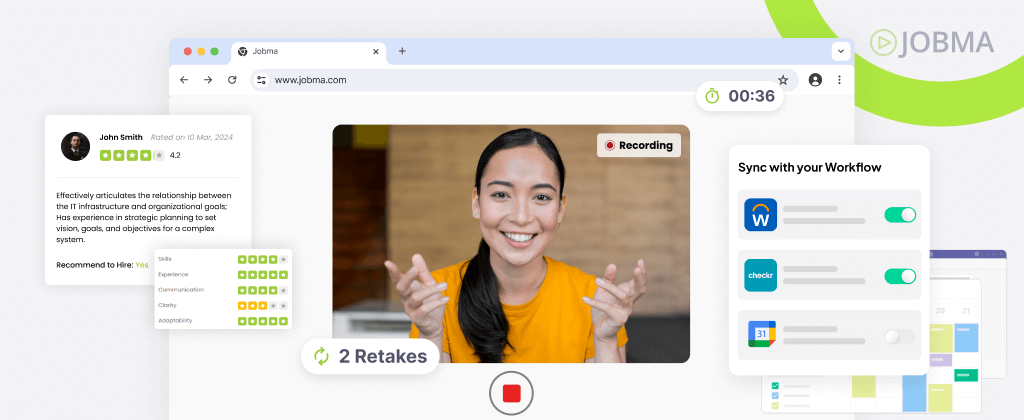Benchmarking Offer-Acceptance Rates in High-Demand Skilled Trades
Skilled trades encompass occupations that require specialized manual skills and technical expertise, often developed through vocational training or apprenticeships. Skilled trades professionals are the hands-on experts behind all field service jobs from reliable wiring and plumbing to climate control, ensuring our buildings stay safe, comfortable, and fully functional every day.
Given the high demand and specialized nature of these roles, hiring skilled trades professionals comes with unique challenges. Employers not only compete for a limited talent pool but also need to act quickly to secure top candidates. That’s why tracking key hiring metrics, such as offer-acceptance rates, time-to-hire, and source effectiveness, is crucial for building a stronger, faster, and more reliable hiring strategy.
You can gauge the offer-acceptance ratio by taking the offers candidates accept, dividing by the total number of offers you extended, and multiplying by 100 to get a percentage. In skilled trades, a healthy benchmark typically ranges from 60 – 70%, although it can vary depending on the role or region. Using these figures as a guide helps you see where to sharpen your hiring strategy.

So, why should you target this ratio? It shapes your ability to forecast open roles, manage budgets, and optimize process speed. Equip yourself with firm benchmarks, and you’re in control rather than reacting.
What Drives Offer Decline Rates in High-Demand Trades
The skilled trades hiring landscape isn’t static. Retirement of experienced workers, low new-worker entry, pending immigration restrictions, and project-heavy demand combine to squeeze labor availability. According to Skillwork, losing five Baby Boomer tradespeople for every two workers joining the field creates a 5:2 departure-to-entry imbalance. That math locks in pressure on your recruitment funnel.
Current stats reveal that 70% of employers report difficulty filling trade roles, and about 75% of U.S. companies report broader labor shortages. Infrastructure investments, including federal programs and private construction booms, fuel demand while limits on apprenticeship spots amplify stress.
In a market with plenty of opportunities but too few skilled workers, tracking your offer-accept ratio and staying competitive is crucial.
What Defines a “Good” Offer‑Accept Ratio?
So, what’s realistic? In practical terms:
- A 50% ratio often signals that the offer terms, pay, schedule, benefits, or timing of outreach need revisiting.
- Ratios between 60-70% align with strong performance in trades like electricians, welders, and plumbers, where increased pay competition is common.
- Rates above 70% place you in the elite territory, reflecting solid compensation, effective candidate experience, and smart timing.
Data-Driven Strategies to Improve Your Ratios
1. Optimize Your Offer Based on Analysis
Historical offer data reveals which packages drive higher acceptance, and candidate feedback pinpoints recurring objections. If HVAC (Heating, Ventilation, and Air Conditioning) candidates consistently walk away over base-pay gaps, weekend or holiday premiums, and tool stipends bridge the difference. Running A/B trials on your offer packages lets you test different combinations of pay rates, bonus structures, and perks to discover what resonates best with candidates.
By splitting your candidate pool into groups and presenting each with a unique package, you can track which version delivers the highest acceptance rate. Armed with that data, you then refine your offers, tweaking elements like signing bonuses or flexible schedules, to build an ever-more compelling proposition that drives steady improvements in your overall offer-accept ratio.
2. Speed Up Your Recruitment Cycle
Speed is often the deciding factor. Skilled candidates often juggle multiple offers. Longer timelines reduce candidate enthusiasm. Asynchronous video interviews eliminate scheduling headaches by letting candidates record standardized questions on their own time and submit responses in minutes. Your team can then review those recordings whenever it’s convenient and share consistent feedback. This speeds up screening from weeks to days, keeps decision-makers aligned, and lets you extend offers before top talent drifts away.
3. Add Real Flexibility
Generic schedules don’t work when candidates juggle personal or family commitments. Offer flexible shifts, compressed workweeks, or weekend-focused roles. Accommodating individual needs signals respect and often unlocks acceptance from otherwise out-of-reach talent. Treat flexibility as a strategic differentiator.
4. Personalize Outreach and Interview Experience
Candidates in high-demand skilled trades value peer insight. Let a prospective teammate reach out for a quick informal chat before the contract is signed. That peer-to-peer touch gives an authentic glimpse into daily routines and culture, reinforcing the decision to join and smoothing conversion.
5. Use Video Interviewing Tools Wisely
Video interviewing software streamlines screening and broadens reach, but technology alone feels impersonal. Keep the human element by sharing clear instructions, offering technical dry runs, and following up live when needed. Striking this balance preserves efficiency while nurturing genuine candidate connections.

Putting It All Together: The Measurement Process
Start with a simple monthly dashboard. You can start by tracking:
- Number of offers extended
- Number of offers accepted
- Offer‑acceptance ratio = (accepted ÷ extended) × 100
Start by segmenting the data by trade, location, and offer type to identify trends, such as why electricians might be slower to fill positions than plumbers. Then, go deeper with metrics like interview-to-offer ratios, candidate satisfaction scores, quality-of-hire at 30 and 90 days, and ROI by source. Use cohort analysis to track how different segments perform over time (e.g., electricians from Region A vs. Region B), and run A/B tests on varying offer structures or communication cadences to see what drives higher acceptance and retention.
According to the World Economic Forum, predictive analytics uses candidate profiles and past hiring results to forecast which groups are most likely to accept offers or drop out, so you can tweak your approach before problems arise.
Addressing Common Challenges
Even after a candidate says “yes” and accepts the offer, a few practical hurdles can still derail the hire. Timing gaps, tech friction, and administrative delays may turn enthusiasm into hesitation. Anticipating these pitfalls and responding quickly keeps the acceptance on track and shows the professionalism candidates expect.

Let’s take a look at these challenges:
Delay Between Offer and Start Date
Even accepted offers can fall through if there’s a gap before the first day. Mitigate by staying connected, calling to check in, sharing orientation details, and confirming equipment needs early. This signals your organization is organized and respects the candidate’s time.
Managing Technology Friction
Video interviewing improves efficiency, though a little extra support may be needed for some candidates who are less familiar with the tech. Avoid missteps by offering walk-throughs, using simple interfaces, and offering live alternatives. Personalize your video interviews by adding branded introductions, role-specific questions, or quick “get-to-know-you” clips that make each candidate feel valued, and layer in interactive bots to answer FAQs, deliver timely updates, or even run short assessments that keep candidates engaged and informed.
Building a Culture That Supports Acceptance
You don’t just compete on pay. High acceptance also relies on your employer brand and culture.
- Paint clear career paths, mention certifications, advancement, and journeyperson progression, to demonstrate investment in growth.
- Promote training time, some candidates value learning new systems and technologies.
- Publicize equipment stipends, tool access, union benefits, safety protocols, and onboarding processes.
- Capture testimonials from recent hires to showcase a supportive culture and minimize risk perception.
When someone hears from a recent hire, sees policies in action, and knows your expectations, it helps them visualize themselves on day one, and helps you win their signature.
Tools to Assist Your Process
Certain features in video interviewing platforms that can support your efforts:
- Asynchronous one-way Q&A for quick screening
- Calendar and ATS integrations, and to accelerate the scheduling
- Peer feedback features bring technicians into the loop early

Platforms like Jobma bring ease to hiring, and when integrated with ATS, they further reduce friction in hiring and skill validation.
Final Thoughts
You’re in a tight labor market shaped by global and demographic constraints. Building a reliable offer‑accept ratio, 60-70% or better, and tracking it month by month gives you clarity. It tells you what works (and what doesn’t) in pay, flexibility, tech, and culture.
Through data-driven iteration, smart tech use, personalization, speed, and peer engagement, you can improve your talent pool significantly. Even a 5-10 percent gain means less downtime, less stress on existing staff, and fewer costs.
A good starting point is to benchmark your hiring data by trade and region, and then compare your current ratios against industry norms. Gathering candidate feedback can help you refine offer structures over time. By observing these metrics month to month, you can gradually develop a playbook that aligns with what your candidates value most.

FAQs
What is an offer-acceptance ratio in recruitment?
Offer-acceptance ratio (OAR) is the percentage of extended job offers that candidates accept. Calculate it by dividing accepted offers by total offers and multiplying by 100. A high OAR means your pay, timing, and candidate experience are competitive – a low one flags friction that’s costing you hires.
What factors impact offer-acceptance rates in the trades sector?
Pay, hiring speed, schedule flexibility, and workplace reputation drive decisions. Skilled tradespeople often juggle multiple offers, so even small pay gaps, slow turnaround, long commutes, or weak safety records can push them to say no, while quick responses and clear growth paths lift acceptance.
Are offer-acceptance ratios different for union vs. non-union trades?
Yes. Union jobs usually post higher OARs, often 70 percent or more, because wages and benefits are preset, leaving candidates fewer reasons to decline. Non-union roles vary widely, anywhere from the low-50s to high-60s, since offers hinge on individualized pay, perks, and negotiation speed.
What tools can help track offer-acceptance ratios in skilled-trade hiring?
Applicant-tracking systems (e.g., Workday, JazzHR, Workable) record offers and outcomes automatically, while video-interview platforms like Jobma feed screening data back into the ATS. AI-powered hiring tools can analyze and surface offer-acceptance trends, helping teams understand what’s working. Smaller hiring teams can track these metrics and trends using spreadsheets, charts, and pivot tables.



